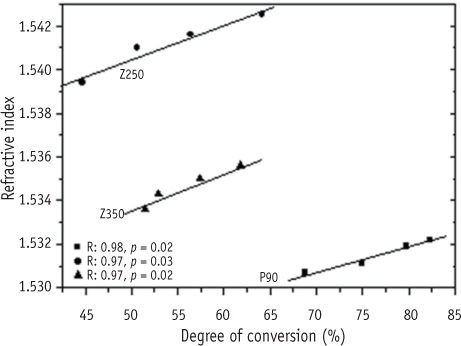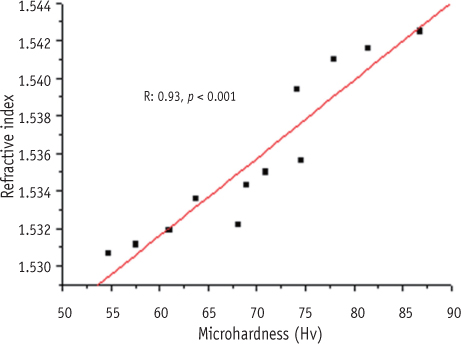Restor Dent Endod.
2014 Nov;39(4):310-318. 10.5395/rde.2014.39.4.310.
The effect of resin thickness on polymerization characteristics of silorane-based composite resin
- Affiliations
-
- 1Department of Conservative Dentistry, School of Dentistry, Pusan National University, Yangsan, Korea. jeongkil@ pusan.ac.kr
- 2Department of Dental Materials, School of Dentistry, Pusan National University, Yangsan, Korea.
- KMID: 2316913
- DOI: http://doi.org/10.5395/rde.2014.39.4.310
Abstract
OBJECTIVES
This study examined the influence of the resin thickness on the polymerization of silorane- and methacrylate-based composites.
MATERIALS AND METHODS
One silorane-based (Filtek P90, 3M ESPE) and two methacrylate-based (Filtek Z250 and Z350, 3M ESPE) composite resins were used. The number of photons were detected using a photodiode detector at the different thicknesses (thickness, 1, 2 and 3 mm) specimens. The microhardness of the top and bottom surfaces was measured (n = 15) using a Vickers hardness with 200 gf load and 15 sec dwell time conditions. The degree of conversion (DC) of the specimens was determined using Fourier transform infrared spectroscopy (FTIR). Scratched powder of each top and bottom surface of the specimen dissolved in ethanol for transmission FTIR spectroscopy. The refractive index was measured using a Abbe-type refractometer. To measure the polymerization shrinkage, a linometer was used. The results were analyzed using two-way ANOVA and Tukey's test at p < 0.05 level.
RESULTS
The silorane-based resin composite showed the lowest filler content and light attenuation among the specimens. P90 showed the highest values in the DC and the lowest microhardness at all depth. In the polymerization shrinkage, P90 showed a significantly lower shrinkage than the rest two resin products (p < 0.05). P90 showed a significantly lower refractive index than the remaining two resin products (p < 0.05).
CONCLUSIONS
DC, microhardness, polymerization rate and refractive index linearly decreased as specimen thickness linearly increased. P90 showed much less polymerization shrinkage compared to other specimens. P90, even though achieved the highest DC, showed the lowest microhardness and refractive index.
MeSH Terms
Figure
Reference
-
1. Bowen RL. Use of epoxy resins in restorative materials. J Dent Res. 1956; 35:360–369.
Article2. Eick JD, Welch FH. Polymerization shrinkage of posterior composite resins and its possible influence on postoperative sensitivity. Quintessence Int. 1986; 17:103–111.3. Sakaguchi RL, Peters MC, Nelson SR, Douglas WH, Poort HW. Effects of polymerization contraction in composite restorations. J Dent. 1992; 20:178–182.
Article4. Eick JD, Kotha SP, Chappelow CC, Kilway KV, Giese GJ, Glaros AG, Pinzino CS. Properties of silorane-based dental resins and composites containing a stress-reducing monomer. Dent Mater. 2007; 23:1011–1017.
Article5. Lien W, Vandewalle KS. Physical properties of a new silorane-based restorative system. Dent Mater. 2010; 26:337–344.
Article6. Papadogiannis D, Kakaboura A, Palaghias G, Eliades G. Setting characteristics and cavity adaptation of low-shrinking resin composites. Dent Mater. 2009; 25:1509–1516.
Article7. Weinmann W, Thalacker C, Guggenberger R. Siloranes in dental composites. Dent Mater. 2005; 21:68–74.
Article8. Ilie N, Hickel R. Silorane-based dental composite: behavior and abilities. Dent Mater J. 2006; 25:445–454.
Article9. Bala O, Uçtasli MB, Tüz MA. Barcoll hardness of different resin-based composites cured by halogen or light emitting diode (LED). Oper Dent. 2005; 30:69–74.10. Rueggeberg FA, Caughman WF, Curtis JW Jr, Davis HC. Factors affecting cure at depths within light-activated resin composites. Am J Dent. 1993; 6:91–95.11. Soh MS, Yap AU, Siow KS. The effectiveness of cure of LED and halogen curing lights at varying cavity depths. Oper Dent. 2003; 28:707–715.12. Emami N, Sjödahl M, Söderholm KJ. How filler properties, filler fraction, sample thickness and light source affect light attenuation in particulate filled resin composites. Dent Mater. 2005; 21:721–730.
Article13. Ferracane JL. Correlation between hardness and degree of conversion during the setting reaction of unfilled dental restorative resins. Dent Mater. 1985; 1:11–14.
Article14. Visvanathan A, Ilie N, Hickel R, Kunzelmann KH. The influence of curing times and light curing methods on the polymerization shrinkage stress of a shrinkage-optimized composite with hybrid-type prepolymer fillers. Dent Mater. 2007; 23:777–784.
Article15. Yap AU. Effectiveness of polymerization in composite restoratives claiming bulk placement: impact of cavity depth and exposure time. Oper Dent. 2000; 25:113–120.16. Chen YC, Ferracane JL, Prahl SA. A pilot study of a simple photon migration model for predicting depth of cure in dental composite. Dent Mater. 2005; 21:1075–1086.
Article17. Schneider LF, Pfeifer CS, Consani S, Prahl SA, Ferracane JL. Influence of photoinitiator type on the rate of polymerization, degree of conversion, hardness and yellowing of dental resin composites. Dent Mater. 2008; 24:1169–1177.
Article18. Bala O, Olmez A, Kalayci S. Effect of LED and halogen light curing on polymerization of resin-based composites. J Oral Rehabil. 2005; 32:134–140.
Article19. Tarle Z, Meniga A, Knezević A, Sutalo J, Ristić M, Pichler G. Composite conversion and temperature rise using a conventional, plasma arc, and an experimental blue LED curing unit. J Oral Rehabil. 2002; 29:662–667.
Article20. Palin WM, Fleming GJ, Burke FJ, Marquis PM, Randall RC. Monomer conversion versus flexure strength of a novel dental composite. J Dent. 2003; 31:341–351.
Article21. Kusgoz A, Ülker M, Yesilyurt C, Yoldas OH, Ozil M, Tanriver M. Silorane-based composite: depth of cure, surface hardness, degree of conversion, and cervical microleakage in Class II cavities. J Esthet Restor Dent. 2011; 23:324–335.
Article22. Palin WM, Fleming GJ, Burke FJ, Marquis PM, Randall RC. The reliability in flexural strength testing of a novel dental composite. J Dent. 2003; 31:549–557.
Article23. D'Alpino PH, Bechtold J, dos Santos PJ, Alonso RC, Di Hipólito V, Silikas N, Rodrigues FP. Methacrylate- and silorane-based composite restorations: hardness, depth of cure and interfacial gap formation as a function of the energy dose. Dent Mater. 2011; 27:1162–1169.24. Rueggeberg FA, Hashinger DT, Fairhurst CW. Calibration of FTIR conversion analysis of contemporary dental resin composites. Dent Mater. 1990; 6:241–249.
Article25. Torres SA, Silva GC, Maria DA, Campos WR, Magalhães CS, Moreira AN. Degree of conversion and hardness of a silorane-based composite resin: effect of light-curing unit and depth. Oper Dent. 2014; 39:e137–e146.
Article26. Guiraldo RD, Consani S, Consani RL, Berger SB, Mendes WB, Sinhoreti MA, Correr-Sobrinho L. Comparison of silorane and methacrylate-based composite resins on the curing light transmission. Braz Dent J. 2010; 21:538–542.
Article27. Andrzejewska E, Lindén LÅ, Rabek JF. The role of oxygen in camphorquinone-initiated photopolymerization. Macromol Chem Phys. 1998; 199:441–449.
Article28. Schulze S, Vogel H. Aspects of the safe storage of acrylic monomers: kinetics of the oxygen consumption. Chem Eng Technol. 1998; 21:829–837.
Article29. Corr AB, Sinhoreti MA, Sobrinho LC, Tango RN, Schneider LF, Consani S. Effect of the increase of energy density on Knoop hardness of dental composites light-cured by conventional QTH, LED and xenon plasma arc. Braz Dent J. 2005; 16:218–224.
Article30. Tilbrook DA, Clarke RL, Howle NE, Braden M. Photocurable epoxy-polyol matrices for use in dental composites I. Biomaterials. 2000; 21:1743–1753.
Article31. Bechtold J, Dos Santos PJ, Anido-Anido A, Di Hipólito V, Alonso RC, D'Alpino PH. Hardness, polymerization depth, and internal adaptation of Class II silorane composite restorations as a function of polymerization protocol. Eur J Dent. 2012; 6:133–140.
Article32. Bouschlicher MR, Rueggeberg FA, Wilson BM. Correlation of bottom-to-top surface microhardness and conversion ratios for a variety of resin composite compositions. Oper Dent. 2004; 29:698–704.33. Eick JD, Kostoryz EL, Rozzi SM, Jacobs DW, Oxman JD, Chappelow CC, Glaros AG, Yourtee DM. In vitro biocompatibility of oxirane/polyol dental composites with promising physical properties. Dent Mater. 2002; 18:413–421.
Article34. Fujita K, Nishiyama N, Nemoto K, Okado T, Ikemi T. Effect of base monomer's refractive index on curing depth and polymerization conversion of photo-cured resin composites. Dent Mater J. 2005; 24:403–408.
Article35. Odian G. Principles of polymerization. 4th ed. New York: John Wiley;2004.36. Shibayama M, Ozeki S, Norisuye T. Real-time dynamic light scattering on gelation and vitrification. Polymer. 2005; 46:2381–2388.
Article
- Full Text Links
- Actions
-
Cited
- CITED
-
- Close
- Share
- Similar articles
-
- Evaluation of polymerization shrinkage stress in silorane-based composites
- Effect of film thickness of resin cement on bonding efficiency in indirect composite restoration
- Evaluation of polymerization ability of resin-based materials used for teeth splinting
- Polymerization shrinkage kinetics of silorane-based composites
- A Study Of Surface Roughness Of Composite Resin




